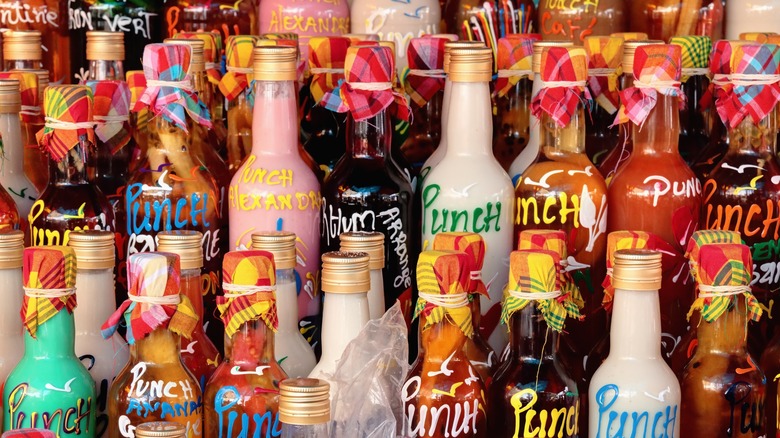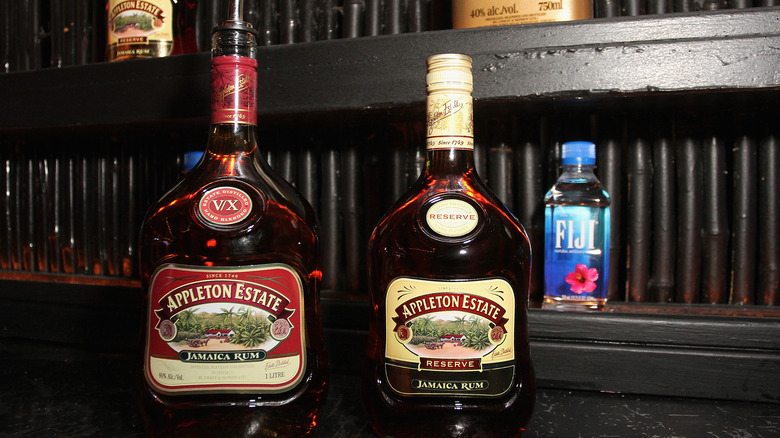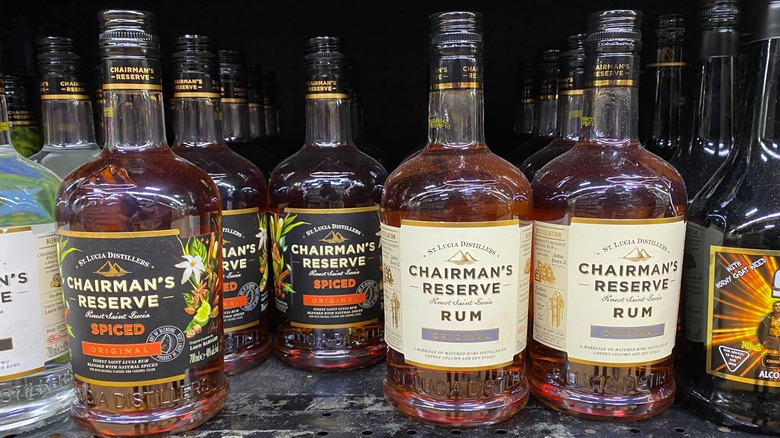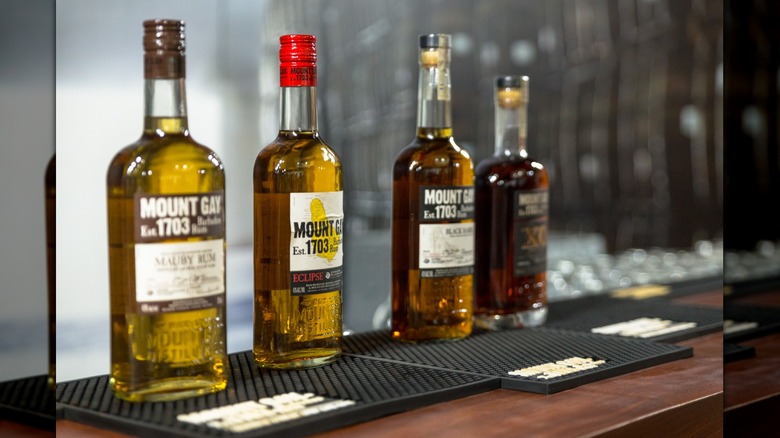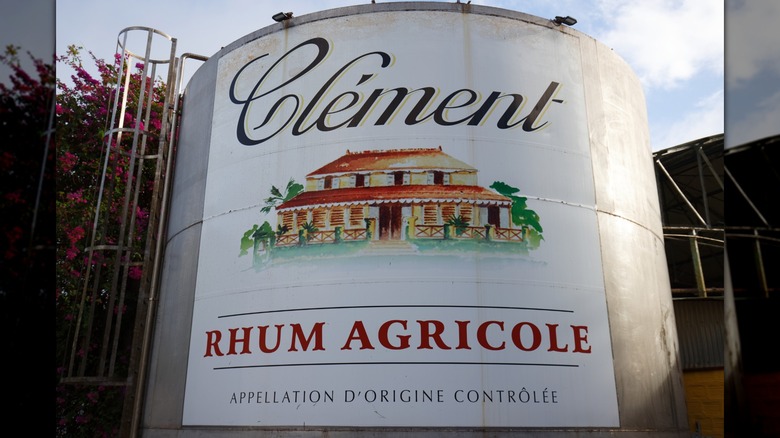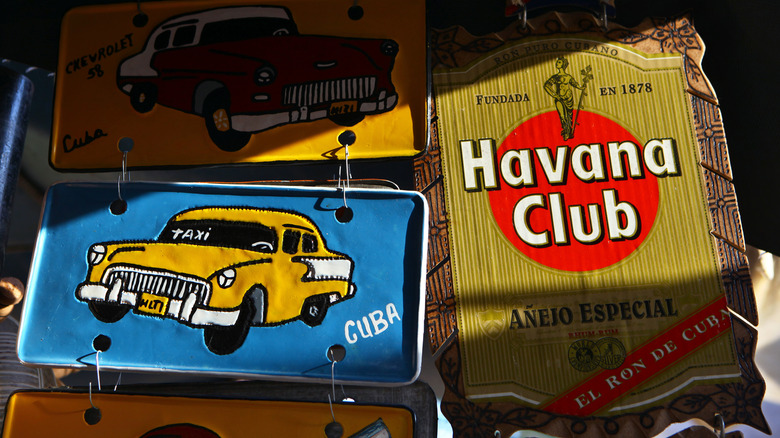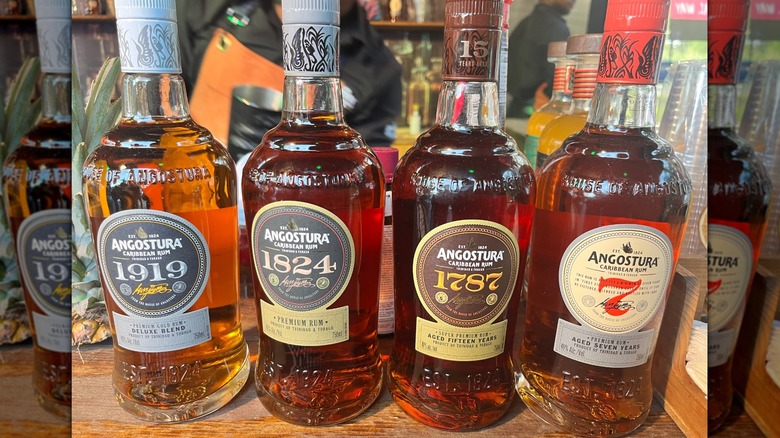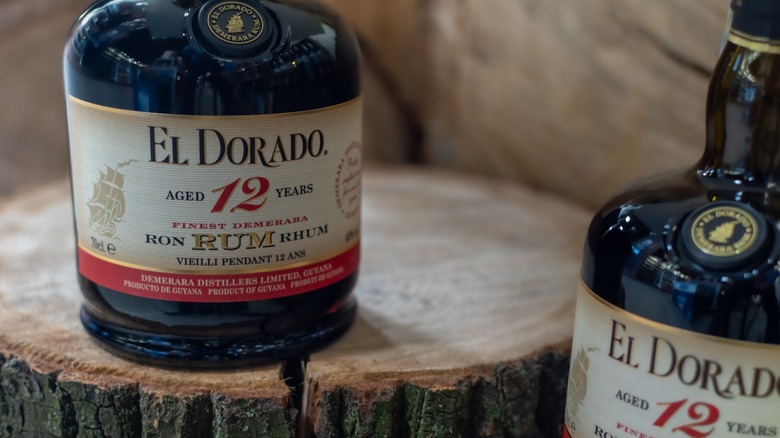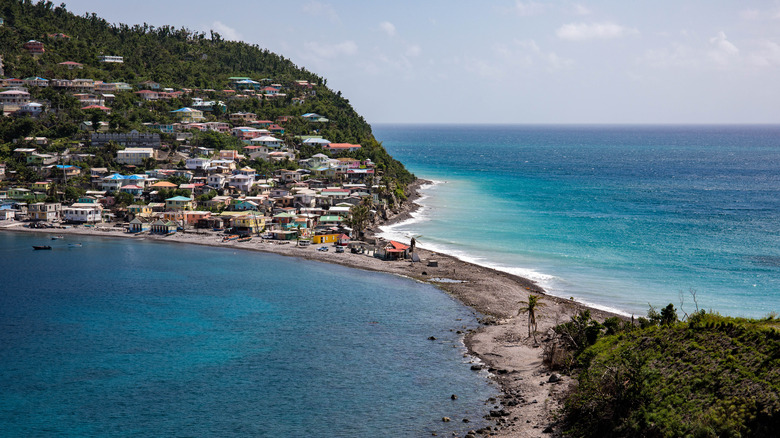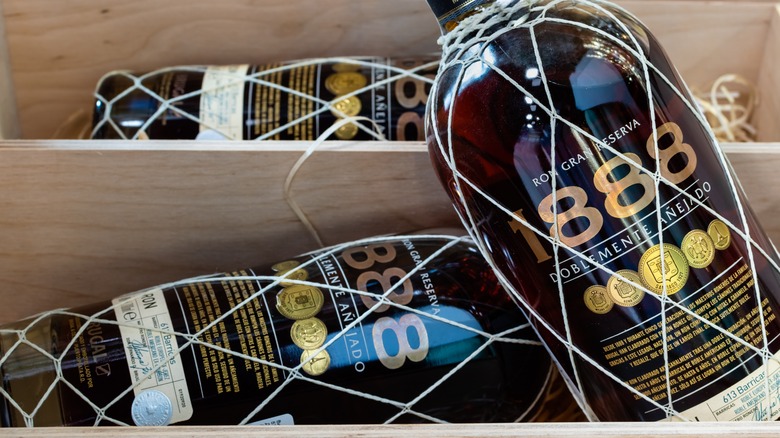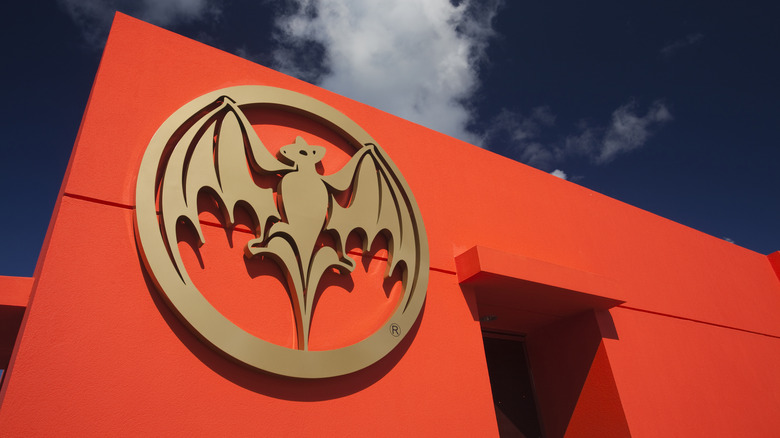10 Types Of Caribbean Rum And What Makes Them Unique, According To A Rum Expert
We may receive a commission on purchases made from links.
If you've ever been to the Caribbean, you know that rum is serious business there . For centuries, the region was a major producer of sugar, the raw material used for making rum. Different islands in the Caribbean developed production methods that gave rise to rums with unique properties.
To get a better sense of exactly what these properties were and how they relate to each place's history and cultural identity, I spoke with Ian Burrell, a self-described "Global Rum Ambassador" whose life has been steeped in rum for decades. "Rum is going to be different in each region of the Caribbean and that's why it's important to distinguish rum by geography," Burrell told me.
Burrell, who has Jamaican roots and was a bartender before becoming one of the world's foremost experts on rum, told me that in Caribbean culture, rum isn't just a drink, it's "a spirit that is part of a way of life." He called rum "eau de vie," French for "water of life." He also just came out with a new book, Rum: A Tasting Guide , which serves as a guide to using rum for anyone who's curious to learn more about the liquor's rich history.
Jamaican rum
It's hard to overstate just how embedded rum is in Jamaican culture. Ian Burrell, who has Jamaican roots, told me he had his first sip of rum when he was just four days old, which I gather is not altogether uncommon on the island. "It's part of a way of life," he said.
Unlike many other Caribbean islands, Jamaica has a geographical indicator, meaning there are certain regulations that distilleries must follow in order to call their product Jamaican rum. "You have to use water from a certain region in Jamaica," Burrell told me, "and if you're using pot stills they have to be one hundred percent copper." While these rules regulate aspects of Jamaican rum, there is still a wide spectrum of styles and flavors that the category encompasses.
While there's no single style of Jamaican rum, there is, Burrell said, a stereotype. "The stereotype Jamaican rum is the funky, heavy, tropical fruit that's seen as something you put into a punch that's really strong," he told me. If you're wondering which type of booze belongs in eggnog, Jamaican rum may be a contender because of its intense flavor. Some Jamaican rums are up to 126 proof, and a rum punch can be deceptively delicious, so if you're sipping punch in Jamaica, pace yourself.
St. Lucia Rum
Like many Caribbean islands, St. Lucia was once a sugar-producing British colony. These days, sugar is no longer a financially viable crop in St. Lucia, so bananas and cacao have become the island's main exports. Rum, however, is still a big business. There is just one rum distillery on the island and it's the largest employer in St. Lucia. The distillery produces a variety of brands, all of which are made using molasses imported from Guyana.
"St. Lucia rums don't have their own distinctive style," Ian Burrell told me. Among the most popular brands distilled on St. Lucia are Bounty, Admiral Rodney, and Chairman's Reserve, each of which is produced using a unique combination of distillation and aging. These are easy enough to find at your local liquor store, but "if you want the proper local stuff, you've got to go to St. Lucia," Burrell said. "The locals love to make their own spiced rums." One famous type of spiced rum from St. Lucia is made with the bark of the bois bandé tree, which is native to the region and is reported to have aphrodisiac qualities. There are many ways to get creative with rum, and this is certainly one of them.
Barbados rum
Home to less than 300,000 people, Barbados punches way above its weight when it comes to rum. In fact, the former British colony is considered by many to be the birthplace of rum in the Caribbean. Barbados is home to Mount Gay, the world's oldest rum distillery, and Foursquare, a smaller distillery that's swept the rum world with its complex, innovative, award-winning rums since it was founded in 1996. Ian Burrell called Foursquare "the Pappy Van Winkle of rums," a reference for any whisky fans out there.
There's a wide variety of Barbadian rum styles. Rum producers on the island use both molasses and sugarcane juice as raw materials, as well as pot and column stills, and each factor influences the final product. According to Burrell, Barbados rum is generally "not as funky [and] a bit more rounded" compared to rum from Jamaica. "It's a lot more palatable to the general consumer," he continued. So if you're new to rum and you're looking for something that's easy to sip and goes down smooth, it's worth seeking out a Barbados rum.
Martinican rum
Martinique is in a uniquely privileged position as a rum-producing Caribbean island. "Because rum is made in lots of developing countries like in the Caribbean," Ian Burrell explains, "it just doesn't have that financial or political might to protect its local product yet." Unlike most Caribbean island nations that gained independence from European powers, Martinique remains a department of France. This association affords the island more resources to protect its cultural heritage with respect to rum.
Geographically specific French products can earn an AOC designation, a legal protection that guarantees that certain products are made according to strict regulations. Unlike most rum, which is made from molasses, Martinican rum must be made from locally sourced sugar cane juice to earn an AOC designation, Burrell told me. They also must use column stills as opposed to copper stills. All of this results in a unique product called "rhum agricole" that's known for its fresh, grassy flavor. "Some find them quite strong," Burrell added. "Their weak rums are like a hundred proof."
Cuban rum
If you live in the U.S., getting your hands on a quality Cuban rum won't be easy. Even if you make it to Cuba, which can be tricky for Americans, you're prohibited from bringing rum back home even if it's for personal consumption. This may be confusing because you've probably heard of one famous Cuban rum brand, Havana Club, that's easy to find at liquor stores in the States. Although the brand has roots in Cuba, Havana Club rum that's sold in the U.S. is actually produced in Puerto Rico and distributed by Bacardi.
The only official rum producer in Cuba is owned by the state and is tightly regulated. To be called Cuban rum, "it has to be [made with] Cuban sugar cane [and] has to be distilled in one of their distilleries there, Ian Burrell explained. But the regulation that most affects Cuban rum's unique flavor is the fact that their rums must be aged for a minimum of two years. "It gives it more complexity," Burrell told me. "Because you're putting the rum in barrels, you're now extracting some natural woody flavors." So if you want to try Cuban rum, you may have to wait for trade restrictions between the US and Cuba to relax, and that might be a while. A classic Cuban cocktail, you can add a rich twist to your mojito by using a real Cuban rum.
Trinidadian rum
Just off the coast of Venezuela, the island of Trinidad is known for its beautiful beaches, massive carnival celebrations, and, of course, rum. After centuries as a lucrative sugar producing colony of Spain and then Britain, the island shuttered its last sugar plantation in 2003. Angostura, famous for its bitters, is now the only distillery left in the country and it makes rum with imported molasses.
Angostura is one of the largest rum producers in the Caribbean. It's "a big, industrial, multi-column behemoth of machinery," Ian Burrell told me. "It's similar to Bacardi's types of stills, so they'll make a rum similar to Bacardi – quite light, easy drinking, easy mixing." Another rum distillery, Caroni, operated on the island until 2003. "Their rum is one of the most sought-after vintage rums," Burrell explained. A quick search revealed that a bottle of Caroni can sell for hundreds and sometimes even thousands of dollars. Rum connoisseurs celebrate Caroni's rums for their oily, tar-like flavor. "That's definitely not a Trinidad style anymore," Burrell said of Caroni's intense flavor, "but it's associated with Trinidadian rums of a bygone era."
Guyana
Guyana is unique among the places on this list in that it's not an island. While it may not have the bustling tourism industry of some Caribbean islands, this South American country produces rum that rivals its more famous neighbors. A former British colony, Guyana was once home to over 300 sugar estates, each of which produced its own rum. Nowadays that number has shrunk to just one: Demerara Distillers, which produces El Dorado brand rum.
According to Ian Burrell, Demerara Distillers "hosts some of the oldest and most iconic stills to make rum that are still around." He explained that they have so many quality stills because as the various distilleries around Guyana closed down, Demerara ended up with their best stills, so they can make a wide variety of rums. In fact, Demerara is the last distillery in the world to operate fully functional wooden stills. "Guyanese rum is always seen as medium bodied, sweeter profile," Burrell said. It's made with local sugar and local molasses, as well as some of the oldest stills in the world. And Burrell wasn't shy about how much he likes rum from Guyana. "The rum distillery in Guyana is one of my favorite rum distilleries in the world," he said. If the painkiller is your new summer drink, try it with a dark or Navy Guyanese rum.
Dominica
Dominica is an island nation sandwiched between the French territories of Martinique and Guadeloupe with a population of just under 75,000. And while the country produces rum, you won't find it at your local liquor store. That's because most of the rum produced in Dominica is black market rum or "bush rum" also known locally as "Mountain Dew." "Most of their rums will be based around cane juice because they're not making any sugar," Ian Burrell said. "It'll be made in small little tiny stills, locally." Because it's produced locally and illicitly, each bush rum is going to have a distinct flavor. It's often infused with different herbs and spices including cinnamon, rosemary, pepper, or anise.
There is one small distillery still on the island called Shillingford Estate and they produce a brand called Macoucherie. The estate has been around for centuries and they make rum the old fashioned way, using locally cut wood to power the distillation process and hydropower from an old aqueduct to crush sugarcane. It's not a scalable business, and exports of the rum are virtually nonexistent. "They're more blenders now," Burrell told me, referring to rum production on the island. "They're buying rums from Guyana and they're also buying rums from the French Caribbean" and blend them to create their own rums.
Dominican Republic
The Dominican Republic, which takes up the eastern part of the island of Hispaniola, is one of a few Caribbean islands still producing sugar commercially. And in the Caribbean, where there's sugar, there's rum. According to Ian Burrell, the Dominican Republic is said to produce "the largest selling brand drunk by Caribbeans in the Caribbean," which is called Brugal. "They make their rums with local sugar cane," he said, and "they'll make their rums very similar to how rums are made in Cuba and Puerto Rico."
The Dominican Republic is a former Spanish colony, and this heritage still influences the way their rums are made. Spanish-style rums tend to be lighter and the flavors are often derived from the barrel-aging process. "They like to use old barrels," Burrell explained, "so it's not giving too much of a wood influence in their rums." Also because of the Spanish connection, some of their rums are aged in former sherry casks, which gives them a unique finish.
Puerto Rico
If you're an American with any history of drinking alcohol, chances are you've been acquainted with Puerto Rican rum. Partially due to the island's unique (and controversial) status as an American territory, Bacardi, Puerto Rico's largest rum distillery, is a household name in the United States. Along with the island's other big distilleries, Puerto Rico supplies the U.S. with around 70% of its rum. Ian Burrell explains that the stereotype of a Puerto Rican rum is "very, very light, very refined, very subtle in flavor." But the island produces such a massive quantity of rum in different styles, so this isn't the only style you'll find in Puerto Rico.
The piña colada was invented in Puerto Rico, so it's no coincidence that the island's signature light rum pairs well with its sweet, tropical flavor. A Christmas drink that tastes great with Puerto Rican rum, coquito, offers comfort, joy, and every tiding in between . Because the Puerto Rican rum industry is so well-developed, many of the island's distilleries offer tours and tastings. Visiting a distillery is a great way to learn how rum is made and to get acquainted with the different production techniques that influence a rum's flavor.
